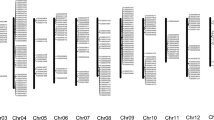Abstract
Three independent genes are responsible for 6-phosphogluconate dehydrogenase (6PGDH) activity in tomato. 6Pgdh-2, located on chromosome 12, codes for subunits of an active dimer which is restricted to the plastids. 6Pgdh-1, chromosome 4, and 6Pgdh-3, chromosome 5, code for subunits which form three dimers—two homodimers and an intergenic heterodimer. The latter three isozymes are found in the cytosol. 6Pgdh-1, 6Pgdh-2, and 6Pgdh-3 code for subunits with estimated molecular weights of 49,500, 50,500, and 51,200, respectively. The intergenic heterodimer encoded by 6Pgdh-1 and 6Pgdh-3 is thus composed of subunits that differ in length by approximately 15 amino acid residues. Divergence in the length and primary subunit structure may account for the lower thermal stability of the intergenic heterodimer compared with the corresponding homodimers. A limited survey of other solanaceous plant species suggests that the duplication of cytosolic 6PGDH-coding genes found in tomato may be widespread in the family.
Similar content being viewed by others
References
Goodman, M. M. and Stuber, C. W. (1983). Maize. In Tanksley, S. D., and Orton, T. J. (eds.), Isozymes in Plant Genetics and Breeding Elsevier, Amsterdam.
Gottlieb, L. D. (1982). Conservation and duplication of isozymes in plants. Science 216373.
Gottlieb, L. D., and Higgins, R. C. (1984). Evidence from subunit molecular weight suggests hybridization was the source of the phosphoglucose isomerase gene duplication in Clarkia. Theor. Appl. Genet. 68369.
Gottlieb, L. S., and Weeden, N. F. (1979). Gene duplication and phylogeny in Clarkia. Evolution 331024.
Laemmli, U. K. (1970). Cleavage of structural proteins during the assembly of the head of bacteriophage T4. Nature 227680.
Morrissey, J. H. (1981). Silver stain for proteins in polyacrylamide gels: A modified procedure with enhanced uniform sensitivity. Anal. Biochem. 117307.
Pearce, B. M. F., and Rosemeyer, M. A. (1974). The molecular weight and subunit structure of human erythrocyte 6-phosphogluconate dehydrogenase. Eur. J. Biochem. 42225.
Pichersky, E., and Gottlieb, L. D. (1983). Evidence for the duplication of the structural genes coding plastid and cytosolic isozymes of triose phosphate isomerase in diploid species of Clarkia. Genetics 105421.
Rick, C. M. (1971). The tomato Ge locus: Linkage relations and geographic distribution of alleles. Genetics 6775.
Rick, C. M. (1975). The tomato. In King, R. C. (ed.), Handbook of Genetics, Vol. 2 Plenum Press, New York, pp. 247–280.
Schaffner, W., and Weissman, C. (1973). A rapid, sensitive, and specific method for the determination of protein in dilute solution. Anal. Biochem. 56502.
Tanksley, S. D. (1983a). Molecular markers in plant breeding. Plant Mol. Biol. Rep. 11.
Tanksley, S. D. (1983b). Gene mapping. In Tanksley, S. D., and Orton, T. J. (eds.), Isozymes in Plant Genetics and Breeding Elsevier, Amsterdam.
Tanksley, S. D. (1984a). Aconitase isozymes—new gene markers for tomato. Rep. Tomato. Genet. Coop. 34 16.
Tanksley, S. D. (1984b). Linkage relationships and chromosomal locations of enzyme-coding genes in pepper, Capsicum annuum. Chromosoma 89352.
Tanksley, S. D., and Rick, C. M. (1980). Isozymic gene linkage map of the tomato: Applications in genetics and breeding. Theor. Appl. Genet. 57161.
Vallejos, C. E. (1983). Enzyme activity staining. In Tanksley, S. D., and Orton, T. J. (eds.), Isozymes in Plant Genetics and Breeding Elsevier, Amsterdam.
Vallejos, C. E., and Tanksley, S. D. (1983). Segregation of isozyme markers and cold tolerance in an interspecific backcross of tomato. Theor. Appl. Genet. 66241.
Weeden, N. F. (1981). Genetic and biochemical implications of the endosymbiotic origin of the chloroplast. J. Mol. Evol. 17133.
Williamson, J. H., Krochko, D., and Geer, B. W. (1980). 6-Phosphogluconate dehydrogenase from Drosophila melanogaster. I. Purification and properties of the A isozyme. Biochem. Genet. 1887.
Zamir, D. (1983). Pollen irradiation in tomato: Minor effects on enzymic gene transfer. Theor. Appl. Genet. 66147.
Author information
Authors and Affiliations
Additional information
This is journal article 1145, Agricultural Experiment Station, New Mexico State University. This research was supported by USDA Grant 82-CRCR-1-1014 to S. D. Tanksley. We acknowledge the technical support of Jaime Iglesias and Fernando Loiaza.
Rights and permissions
About this article
Cite this article
Tanksley, S.D., Kuehn, G.D. Genetics, subcellular localization, and molecular characterization of 6-phosphogluconate dehydrogenase isozymes in tomato. Biochem Genet 23, 441–454 (1985). https://doi.org/10.1007/BF00499085
Issue Date:
DOI: https://doi.org/10.1007/BF00499085




